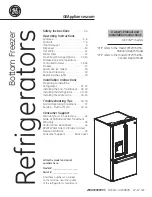
Never use sharp metal tools to scrape off frost from the evaporator as you could damage it.
Do not use a mechanical device or any artificial means to speed up the thawing process
other than those recommended by the manufacturer. A temperature rise of the frozen food
packs, during defrosting, may shorten their safe storage life.
WHAT TO DO IF…
CAUTION!
Before troubleshooting, disconnect the power supply.
Only a qualified electrician or competent person must do the troubleshooting that is not in
this manual.
There are some sounds during normal use (compressor, refrigerant circulation).
Problem
Possible cause
Solution
The appliance is noisy.
The appliance is not supported
properly.
Check if the appliance stands sta
-
ble (all the four feet should be on
the floor).
The compressor operates
continually.
The Temperature regulator may
be set incorrectly.
Set a warmer temperature.
The door is not closed correctly.
Refer to "Closing the door".
The door has been opened too
frequently.
Do not keep the door open longer
than necessary.
The product temperature is too
high.
Let the product temperature de
-
crease to room temperature be
-
fore storage.
The room temperature is too
high.
Decrease the room temperature.
Water flows on the rear
plate of the refrigerator.
During the automatic defrosting
process, frost defrosts on the
rear plate.
This is correct.
Water flows into the re-
frigerator.
The water outlet is clogged.
Clean the water outlet.
Products prevent that water
flows into the water collector.
Make sure that products do not
touch the rear plate.
Water flows on the
ground.
The melting water outlet does
not flow in the evaporative tray
above the compressor.
Attach the melting water outlet
to the evaporative tray.
There is too much frost
and ice.
Products are not wrapped prop
-
erly.
Wrap the products better.
The door is not closed correctly.
Refer to "Closing the door".
The Temperature regulator may
be set incorrectly.
Set a higher temperature.
What to do if…
13














































